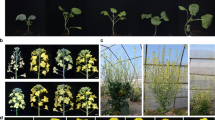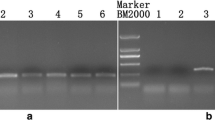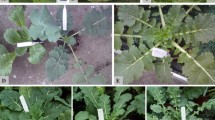Abstract
Ogura cytoplasmic male sterility (Ogu-CMS) is widely used in the production of commercial hybrids of Brassica oleracea. However, the widespread application of the Ogu-CMS system in B. oleracea has hindered the germplasm innovation of Ogu-CMS resources due to the lack of a natural restorer line. Previously, the Ogu-CMS fertility-restored interspecific hybrids between rapeseed 15Y403 (2n = 38, AACC) and Chinese kale JL1 (2n = 18, CC) have been successfully produced. However, these progenies, which still contained a large proportion of rapeseed genomic components, showed poor fertility and a low seed setting rate under natural pollination. To improve fertility and seed setting, a successive backcross with JL1 was performed to produce BC2 progenies. Screening with the Rfo-specific marker, five individuals harboring the Rfo gene were identified among 98 BC2 progenies. These five individuals underwent background marker screening and an evaluation of agronomic traits and fertility. One individual (code: 15Q23) was identified with higher pollen viability, better seed setting under natural pollination, and a closer genetic background to the parent Chinese kale JL1. Many morphological traits showed no significant differences (P < 0.05) between 15Q23 and the backcross parent JL1. However, the average seed setting of 15Q23 under natural pollination was 0.72 seeds per pod, which was 50 times higher than that of BC1 progenies, and the average pollen viability was 87.07%, which was significantly better than that of the F1 and BC1 plants (P < 0.01). The genetic background of 15Q23 was more closer to the parent JL1 than that of BC1 plants and another BC2 fertility-restored individual, with 82% of the polymorphic alleles being the same as those of the parent Chinese kale JL1. Thus, the individual 15Q23 could be used as a donor plant for further backcrosses. This study lays the foundation for the development of Ogu-CMS restorer material in B. oleracea.





Similar content being viewed by others
References
Ayotte R, Harney PM, Machado VS (1987) The transfer of triazine resistance from Brassica napus L. to B. oleracea L. I. Production of F1 hybrids through embryo rescue. Euphytica 36:615–624
Bannerot H, Boulidard L, Couderon Y, Temple J (1974) Transfer of cytoplasmic male sterility from Raphanus sativus to Brassica oleracea. In: Wills AB, North C (eds) Proceedings of Eucarpia Meet Cruciferae. Scottish Hortic Res Inst, Invergavrie, pp 52–54
Bellaoui M, Grelon M, Pelletier G, Budar F (1999) The restorer Rfo gene acts post-translationally on the stability of the ORF138 Ogura CMS-associated protein in reproductive tissues of rapeseed cybrids. Plant Mol Biol 40(5):893–902
Brown GG, Formanova N, Jin H, Wargachuk R, Dendy C, Patil P et al (2003) The radish Rfo restorer gene of Ogura cytoplasmic male sterility encodes a protein with multiple pentatricopeptide repeats. Plant J 35:262–272
Budahn H, Schrader O, Peterka H (2008) Development of a complete set of disomic rape-radish chromosome-addition line. Euphytica 162:117–128
Chen S, Nelson M, Chevre A, Jenczewski E, Li Z et al (2011) Trigenomic bridges for brassica improvement. Crit Rev Plant Sci 30:524–547
Chen J, Ren XS, Song HY, Li CQ, Yuan TC, Si J (2016) Identification of races of plasmodiophora brassicae from four different regions and resistance identification of new cabbage cross combination. J Southwest Univ 38(1):67–72
Comai L (2000) Genetic and epigenetic interactions in allopolyploid plants. Plant Mol Biol 43:387–399
Delourme R, Eber F, Renard M (1991) Radish cytoplasmic male sterility in rapeseed: breeding restorer lines with a good female fertility. In: Proceedings of 8th International Rapeseed Congress. University Extension Press, University of Saskatchewan, Saskatoon, pp 1506–1510
Delourme R, Eber F, Renard M (1995) Breeding double low restorer lines in radish cytoplasmic male sterility of rapeseed (Brassica napus L.). In: Proceedings of 9th International Rapeseed Congress, vol 1, Cambridge, pp 6–8
Delourme R, Foisset N, Horvais R, Barret P, Champagne G, Cheung WY, Landry BS, Renard M (1998) Characterisation of the radish introgression carrying the Rfo restorer gene for the Ogu-INRA cytoplasmic male sterility in rapeseed (Brassica napus L.). Theor Appl Genet 97:129–134
Delourme R, Horvais R, Vallee P, Renard M (1999) Double low restored F1 hybrids can be produced with the Ogu-INRA CMS in rapeseed. In: Proceedings of 10th International Rapeseed Congress Canberra, pp 26–29
Ding L, Zhao ZG, Ge XH, Li ZY (2013) Intergeneric addition and substitution of Brassica napus, with different chromosomes from Orychophragmus violaceus: phenotype and cytology. Sci Hortic-Amsterdam 164:303–309
Du XZ, Ge XH, Yao XC, Zhao ZG, Li ZY (2009) Production and cytogenetic characterization of intertribal somatic hybrids between Brassica napus and Isatis indigotica and backcross progenies. Plant Cell Rep 28:1105–1113
Fang ZY, Sun PT, Liu YM, Yang LM, Wang XW, Hou AF, Bian CS (1997) A male sterile line with dominant gene (MS) in cabbage (Brassica oleracea var. capitata) and its utilization for hybrid seed production. Euphytica 97:265–268
Fang ZY, Sun PT, Liu YM, Yang LM, Wang XW, Zhuang M (2001) Investigation of different types of male sterility and application of dominant male sterility in cabbage. China Veg 1:6–10
Fang ZY, Liu YM, Yang LM, Wang XW, Zhuang M, Zhang YY, Sun PT (2002) A survey of research in genetic breedings of cabbage in China. Acta Hortic Sin (Suppl) 29:S657–S663
Feng J, Primomo V, Li Z, Zhang Y, Jan CC, Tulsieram L, Xu SS (2009) Physical localization and genetic mapping of the fertility restoration gene Rfo in canola (Brassica napus L.). Genome 52:401–407
Gautam M, Dang Y, Ge X, Shai Y, Li Z (2016) Genetic and epigenetic changes in oilseed rape (Brassica napus L.) extracted from intergeneric allopolyploid and additions with Orychophragmus. Front Plant Sci 7:438
Heyn FW (1976) Transfer of restorer genes from Raphanus to cytoplasmic male sterile Brassica napus. Cruciferae Newsl 1:15–16
Kalloo G (1992) Utilization of wild species. In: Kalloo G, Chawdhury JB (eds) Distant hybridiza tion of crop plants. Springer, Berlin, pp 149–167
Kang L, Du X, Zhou Y, Zhu B, Ge X, Li Z (2014) Development of a complete set of monosomic alien addition lines between Brassica napus and Isatis indigotica (Chinese woad). Plant Cell Rep 33:1355–1364
Kirti PB, Banga SS, Prakash S, Chopra VL (1995) Transfer of Ogu cytoplasmic male sterility to Brassica juncea and improvement of the male sterile line through somatic cell fusion. Theor Appl Genet 91:517–521
Leflon M, Eber F, Letanneur J, Chelysheva L, Coriton O, Huteau V, Ryder C, Barker G, Jenczewski E, Chevre A (2006) Pairing and recombination at meiosis of Brassica rapa (AA) × Brassica napus (AACC) hybrids. Theor Appl Genet 113:1467–1480
Li ZY, Ge XH (2007) Unique chromosome behaviour and genetical control in Brassica × Orychophragmus wide hybrids: a review. Plant Cell Rep 36:701–710
Li ZY, Hua YW, Ge XH, Xu CY (2005) Chromosomal behaviors in plant wide hybridizations and their genetic and evolutionary implications. Hereditas 27:315–324
Li QF, Mei JQ, Zhang YJ, Li JN, Ge XH, Li ZY, Qian W (2013) A large-scale introgression of genomic components of Brassica rapa, into B. napus, by the bridge of hexaploid derived from hybridization between B. napus, and B. oleracea. Theor Appl Genet 126:2073–2080
Li Q, Zhou Q, Mei J, Zhang Y, Li J, Li Z, Ge X, Xiong Z, Huang Y, Qian W (2014) Improvement of Brassica napus via interspecific hybridization between B. napus and B. oleracea. Mol Breed 34:1955–1963
Lv W, Wang Y, Zhao J, Gu A, Li Y, Guan Z, Shen S (2011) Generation and identification of Chinese cabbage-cabbage disomic alien addition line 1. Acta Hortic Sin 38:1275–1282
Mei J, Liu Y, Wei D, Wittkop B, Ding Y et al (2015) Transfer of sclerotinia resistance from wild relative of Brassica oleracea, into Brassica napus, using a hexaploidy step. Theor Appl Genet 128:639–644
Ogura H (1968) Studies on the new male sterility in Japanese radish, with special reference to the utilization of this sterility towards practical raising of hybrid seed. Mem Fac Agric Kagoshima Univ 6:39–78
Pellan-Delourme R, Renard M (1988) Cytoplasmic male sterility in rapeseed (Brassica napus L.): female fertility of restored rapeseed with “Ogura” and cybrids cytoplasms. Genome 30:234–238
Pelletier G, Primard C, Vedel F, Chetrit P, Remy R, Rousselle P, Renard M (1983) Intergeneric cytoplasmic hybridization in Cruciferae by protoplast fusion. Mol Gen Genet 191:244–250
Pradhan A, Plummer JA, Nelson MN, Cowling WA, Yan G (2010) Successful induction of trigenomic hexaploid Brassica from a triploid hybrid of B. napus L. and B. nigra (L.) Koch. Euphytica 176:87–98
Primard-Brisset C, Poupard JP, Horvais R, Eber F, Pelletier G, Remard M, Delourme R (2005) A new recombined double low restorer line for the Ogu-INRA cms in rapeseed (Brassica napus L.). Theor Appl Genet 111:736–746
Ripley VL, Beversdorf WD (2003) Development of self-incompatible Brassica napus (I) introgression of S-alleles from Brassica oleracea through interspecific hybridization. Plant Breed 122:1–5
Rohlf F (1997) NTSYS-PC 2.1. Numerical taxonomy and multivariate analysis system. Exeter Software In, Setau-ket, NY
Roy NN (1984) Interspecific transfer of Brassica juncea-type blackleg resistance to Brassica napus. Euphytica 33:295–303
Saal B, Brun H, Glais I, Struss D (2004) Identification of a Brassica juncea -derived recessive gene conferring resistance to Leptosphaeria maculans in oilseed rape. Plant Breed 123:505–511
Saghai-Maroof MA, Soliman KM, Jorgensen RA, Allard RW (1984) Ribosomal DNA spacer-length polymorphisms in barley: mendelian inheritance, chromosomal location, and population dynamics. Proc Natl Acad Sci USA 81:8014–8018
Sun L, Li X et al (2008) Descriptors and data standards for Chinese kale (Brassica alboglabra Bailey). China Agriculture Press, Beijing
Tu Y, Sun J, Liu Y, Ge X, Zhao Z, Yao X, Li Z (2008) Production and characterization of intertribal somatic hybrids of Raphanus sativus, and Brassica rapa, with dye and medicinal plant Isatis indigotica. Plant Cell Rep 27:873–883
Tu Y, Jian S, Ge X, Li Z (2009) Chromosome elimination, addition and introgression in intertribal partial hybrids between Brassica rapa and Isatis indigotica. Ann Bot 103:1039–1048
Walters WT, Mutschler AM, Earle DE (1992) Protoplast fusion-derived Ogura male-sterile cauliflower with cold tolerance. Plant Cell Rep 10:624–628
Wang QB, Zhang YY, Fang ZY, Liu YM, Yang LM, Zhuang M (2012) Chloroplast and mitochondrial SSR help to distinguish allo-cytoplasmic male sterile types in cabbage (Brassica oleracea L. var. capitata). Mol Breed 30:709–716
Wei BQ, Wei YS (1995) Transfer and development the Ogura cytoplasmic male sterility line in Chinese cabbage. China Veg 5:18–21
Wen J, Tu JX, Li ZY, Fu TD, Ma CZ, Shen JX (2008) Improving ovary and embryo culture techniques for efficient resynthesis of Brassica napus from reciprocal crosses between yellow-seeded diploids B. rapa and B. oleracea. Euphytica 162:81–89
Yang LM, Fang ZY, Liu YM, Zhuang M, Zhang YY, Sun PT (2011) Advances of research on cabbage genetics and breeding during ‘The Eleventh Five-year Plan’ in China. China Veg 2:1–10
Yarrow SA, Burnett LA, Wildeman RP, Kemble RJ (1990) The transfer of ‘Polima’ cytoplasmic male sterility from oilseed rape (Brassica napus) to broccoli (B. oleracea) by protoplast fusion. Plant Cell Rep 9:185–188
Yu HL, Fang ZY, Liu YM, Yang LM, Zhuang M, Lv HH, Li ZS, Zhang YY (2015) Genetic background screen of inter-specific hybrids between SSR marker assisted Chinese kale and rapeseed. China Veg 8:14–21
Yu HL, Fang ZY, Liu YM, Yang LM, Zhuang M, Lv HH, Li ZS, Han FQ, Liu XP, Zhang YY (2016) Development of a novel allele-specific Rfo marker and creation of Ogura CMS fertility-restored interspecific hybrids in Brassica oleracea. Theor Appl Genet 129:1625–1637
Zhang GQ, Tang GX, Song WJ, Zhou WJ (2004) Resynthesizing Brassica napus from interspecific hybridization between Brassica rapa and B. oleracea through ovary culture. Euphytica 140:181–187
Zhang D, Chen B, Zhang F, Yu Y, Zhao X, Yu S, Xu J (2009) Molecular identification of a purple Chinese cabbage CMS material. Acta Agric Boreali Sin 24:174–178
Zhang XL, Li ZS, Fang ZY, Li BJ, Chai AL, Sun JF, Yang LM, Zhuang M, Zhang YY, Zhang LL, Fan YY, Sun PT, Liu YM (2014) Genetic analysis of clubroot resistant in the populations of broccoli × wild cabbage accession ‘B2013’. Acta Hortic Sin 41:2225–2230
Zhang YK, Gu AX, Meng C, Meng YN, Liu LP, Xuan SX, Wang YH, Shen SX (2015) Generation and phenotype of Chinese cabbage-cabbage disomic alien addition lines 4. Acta Hortic Sin 42:1576–1582
Zhao ZG, Hu TT, Ge XH, Du XZ, Ding L, Li ZY (2008) Production and characterization of intergeneric somatic hybrids between Brassica napus and Orychophragmus violaceus and their backcrossing progenies. Plant Cell Rep 27:1611–1621
Zhu Q, Kang ZL, Jian YC, Ding YH, Kang JG (2012) The molecular characteristics of Ogura cytoplasmic male sterility related gene orf138 in cabbage (Brassica oleracea var. capitata). Chin Agric Bull 28:104–109
Acknowledgements
This work was supported by grants from the Major State Research Development Program (2016YFD0101702), the Science and Technology Innovation Program of Chinese Academy of Agricultural Sciences (CAAS-ASTIP-IVFCAAS) and the earmarked fund for the Modern Agro-Industry Technology Research System, China (nycytx-35-gw01). This work was performed in the Key Laboratory of Biology and Genetic Improvement of Horticultural Crops, Ministry of Agriculture, Beijing 100081, People’s Republic of China.
Author contribution
YH and ZY conceived and designed the research. YH and LZ conducted experiments and wrote the manuscript. All authors read and approved the manuscript.
Author information
Authors and Affiliations
Corresponding authors
Ethics declarations
Conflict of interest
The authors declare that they have no conflict of interest.
Additional information
Hai-long Yu and Zhi-yuan Li have contributed equally to this work.
Electronic supplementary material
Below is the link to the electronic supplementary material.

10681_2017_1842_MOESM2_ESM.jpg
Supplementary Fig. S2 Cluster analysis among parent Chinese kale (JL1), parent rapeseed (15Y403), F1 (YL2), partial fertility-restored BC1 plants (14Y1, 14Y9, 14Y19) and BC2 Rfo-positive individuals (15Y24, 15Y52, 15Q6, 15Q9, 15Q23) (JPEG 1268 kb)

10681_2017_1842_MOESM3_ESM.jpg
Supplementary Fig. S3 Morphological characterization of leaf shape (a) and the inflorescence and flower of the BC1 F1 self progenies (b-e) (JPEG 2331 kb)
Rights and permissions
About this article
Cite this article
Yu, Hl., Li, Zy., Yang, Lm. et al. Morphological and molecular characterization of the second backcross progenies of Ogu-CMS Chinese kale and rapeseed. Euphytica 213, 55 (2017). https://doi.org/10.1007/s10681-017-1842-3
Received:
Accepted:
Published:
DOI: https://doi.org/10.1007/s10681-017-1842-3




